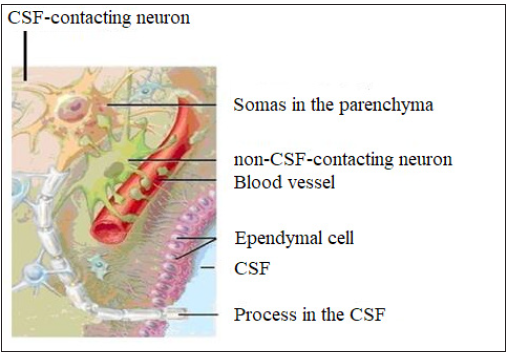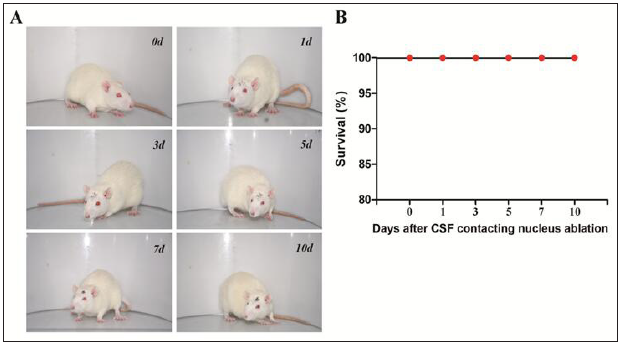- Submissions

Full Text
Open Access Research in Anatomy
The Discovery of the CSF-Contacting Nucleus and Research
Song SY, Zhang LC*
Jiangsu Province Key Laboratory of Anesthesiology, China
*Corresponding author: Zhang LC, Jiangsu Province Key Laboratory of Anesthesiology, China
Submission: December 10, 2019;Published: December 20, 2019

ISSN: 2577-1922
Volume2 Issue2
Opinion
As is known to all, the mammalians’ brain has 12 pairs of cranial nuclei. They act their own functions individually for modulating life activities. During 30 years of continuous research, our research group discovered and confirmed that there exists another special nucleus in the brain: cerebrospinal fluid contacting nucleus (CSF-contacting nucleus). The unique feature of this nucleus is that the neural somas are located in the brain parenchyma, but the processes are stretched into the CSF (Figure 1). It has broad synaptic connections with other brain functional areas. It can also connect with the CSF and blood via non-synaptic structure and become a key structure mediating the bidirectional crosstalk between the neuron and body fluids. The confirmation of this nucleus provides clear morphological evidence of comprehending the coordinating and unifying of the neuron and body fluids under the existence of neuron-body fluids barriers. It also provides the source of the substance changes in the CSF under different pathological situations. Based on the fact that the already known 12 pair of cranial nuclei connect with somatic or visceral substantial organs, however, the scientific world has not reported the description of the nucleus connect with body fluids. It is no doubt regret for clarifying the coordinating and unifying between the neural and body fluids systems. The confirmation of the CSF-contacting nucleus not only adds the new content to the brain structures, but also brings new ideas to the operation theory of life activities and the intervention approaches of related diseases. Based on these reasons, the CSF-contacting nucleus can be regarded as XIII pair of cranial nuclei and is of great scientific significance to life science and medicine [1].
Figure 1: Schematic diagram of the CSF-contacting neurons. The neural somas are located in the brain parenchyma, but the processes are stretched in the cerebrospinal fluid (CSF).

This original research has lasted for nearly 30 years. Our group has won more than 10 national and provincial natural science funds and published more than 100 academic papers. In 2010, it won the first prize of science and technology of Jiangsu Province. Since then, we have carried out nearly 10 years of research, and obtained clear results on the exact location of the CSF-contacting nucleus in the brain (Figure 2), spatial shape, neuron properties and its connections with the whole brain (Figure 3). At the same time, we have established a specific model animal of CSF-contacting nucleus “knock out”, which will provide a scientific and reliable methodology basis to further explore the life regulation law of neuron-body fluids communication and endocrine immunity (Figure 4).
Figure 2: The core section of the CSF-contacting nucleus in the brain.

Figure 3: Schematic diagram of the CSF-contacting neurons receives the projections from cortical functional areas and positive retrograde labeled neurons in the insular cortex.

Figure 4: The establishment of the CSF-contacting nucleus “knock-out” model animal and its effects on life activities [1].

References
© 2019 Zhang LC. This is an open access article distributed under the terms of the Creative Commons Attribution License , which permits unrestricted use, distribution, and build upon your work non-commercially.
 a Creative Commons Attribution 4.0 International License. Based on a work at www.crimsonpublishers.com.
Best viewed in
a Creative Commons Attribution 4.0 International License. Based on a work at www.crimsonpublishers.com.
Best viewed in 







.jpg)






























 Editorial Board Registrations
Editorial Board Registrations Submit your Article
Submit your Article Refer a Friend
Refer a Friend Advertise With Us
Advertise With Us
.jpg)






.jpg)














.bmp)
.jpg)
.png)
.jpg)










.jpg)






.png)

.png)



.png)






